skip to main |
skip to sidebar
Another of those long goods-train-like, really catchy names that I'm so good at manufacturing. But this time, consider ooey-gooey to be the adjective that qualifies the noun (hey, I did English Literature in college, can you tell?). The noun here being the actual title for this post (and the cake) - which is, of course, pineapple pudding cake. Not too bad, that. Straightforward and factual. With a bit of English grammar thrown in gratis.
Considering that I hadn't really had much faith in the outcome of the recipe (I'm a major Doubting Thomas, me!), I was rather pleased with the result. I got the recipe off a lycos food group that I subscribe to - that is to say, I subscribed looooong back and didnt get around to unsubscribing. Partly because I couldnt be bothered, and partly because once in a while, I manage to salvage a little drop from the massive waves of recipes that crash into my inbox every day.
Are you wondering if this pineapple pudding cake is one of those salvaged drops? Yes, sort of. Sometimes those drops of water turn out to be little sparkly gems, and sometimes they're just - well, a recipe that manages to work. This is one of the latter kind... not quite a gem, but not dross either. That's my opinion. My mother and Pete - especially Pete - thought it was incredibly good.
I had serious doubts about the glaze (for want of a better name) for the cake. The cake itself wasnt bad, for an eggless one, using the one-bowl method. But the recipe said the glaze had to be poured boiling hot over the hot cake. I had mental visions of the cake promptly disintegrating into a soggy mess, so I hesitated an awful lot before going ahead. My mother didnt help by peering at the contents of the saucepan - which was bubbling merrily, a mixture of evaporated milk, a bit of condensed milk, margarine, sugar and chopped nuts - and saying in an extremely doubtful tone: "Are you going to pour THAT over the cake?"
I suppose that did it. I consider myself at perfect liberty to second-guess instructions in other people's recipes and query methods given in cookery books - but to be second-guessed about something I'm making (even if from some unknown recipe) is not on.
So before anyone else could convey their doubtful disbelief, I promptly poured the hot glaze over the hot cake - but then I was too chicken to follow through on the consequences. Basically, after pouring the glaze, I turned my back on the cake, switched off the kitchen light and went off to watch a movie.
Did I think about the cake? Nope. Not at all.
A few hours later, I went to check on the cake somewhat fearfully, expecting to see a disintegrated mess on the plate - but to my surprise, the cake was still standing. All the excess glaze that had overflowed on the plate had been soaked up by the cake itself.
Thrilled to see the whole thing still in one piece, I let Pete cut himself a slice. It was ooey and gooey and more pudding than cake - he had it with honey vanilla icecream and pronounced the combination delectable. When I tried it, I found it rather too sweet for my liking - but my sweet tooth is very quickly satisfied, so I'm not the best judge.

The final verdict is: If you like gooey moist sweet cakes, this is the one for you. The glaze sort of caramelized (if that's the right term) to a darkly sweet texture - you could certainly say that the sum of the parts added to more than the whole! Or something like that, anyway.
Recipe for: Pineapple pudding cake
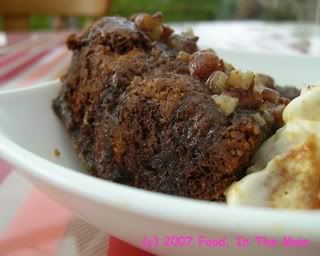
Ingredients:
For the cake:
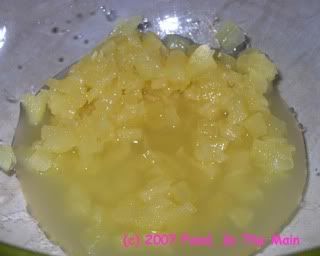
1 cup crushed pineapple with juice (NOT syrup)
1/2 cup white sugar
1-1/2 cups plain flour
3 tsp baking soda
2 tbsp milk
1/2 tsp baking powder
1/4 tsp salt
1/4 cup vegetable oil
2 tbsp demerara sugar (or use brown sugar)
For glaze or topping:
1/2 cup evaporated milk
3 tbsp condensed milk
1/4 cup butter or margarine
1/2 cup white sugar
1 tsp. vanilla
1/4 cup chopped pecans
Method:
1. In a large bowl, mix all the cake ingredients together (except the demerara/brown sugar) until the flour is incorporated. The batter will be quite thick.
2. Scrape batter into a greased 6" round cake pan. Even it out with the back of a wetted spoon.
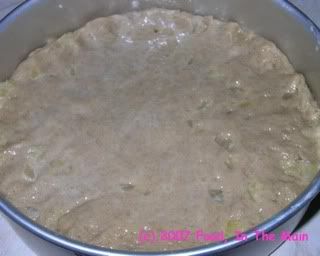
3. Then sprinkle the demerara or brown sugar over the top.
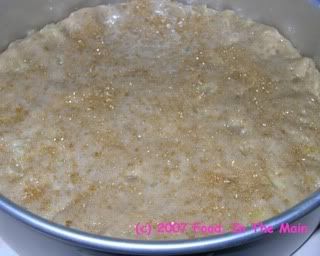
4. Bake at 180C (350F) for about 45 mnutes or till the cake tests done and has pulled away slightly from the sides.
5. When the cake has been in the oven for about 35 minutes, make the glaze/topping. Put all the topping/glaze ingredients in a small pan.

6. Bring to a boil on medium heat, stirring till the butter/margarine has melted completely, and let it bubble gently for a couple of minutes.
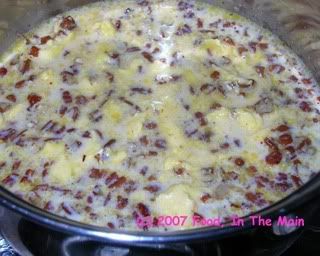
7. When the cake is done, turn it out onto a serving plate.

8. While it is still hot, pour the hot topping on the cake.

9. Let it cool completely (preferably leave it overnight) before cutting. Serve with vanilla icecream.
Regular readers might be aware of my less-than-enthusiastic outlook when it comes to the edibility of aubergines (brinjals or eggplant, in other words). But there are plenty of people who DO like them - my mother and my husband, to name two. So I dont really mind making aubergine recipes for them. Just as long as nobody asks me to eat what I make, I'm happy.
I've seen various stuffed aubergine recipes on the Net, and all of them seem perfectly good recipes... but I thought I would try out my own combination of ingredients for the stuffing and come up with something slightly different. Mind, though, I probably wouldnt have considered peanuts as a stuffing ingredient had I not read so many posts in Indira's blog where she's used peanuts in so many ways!
I also pounded all the ingredients to a coarse powder using a mortar and pestle. It would have taken me all of one minute to do it in the dry grinder, but I decided to go the hard way and pound away for 10 minutes with the blessed mortar and pestle.
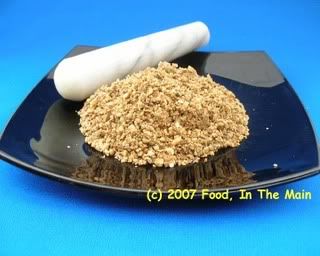
The only reason I did it was because I didnt want the peanuts and sesame seeds to get hot, exude oil and turn into a paste instead of a powder. (It can happen in a dry grinder because of the heat from the machine, as both peanuts and sesame seeds are oil-rich.)
Now I cant personally vouch for the taste of this recipe because I didnt try it, but it got a thumbs-up from my mother, for whom I made this dry-ish curry. In return, she kindly made me potato fry. Talk about perfect give-and-take!
Recipe for: Stuffed baby aubergines
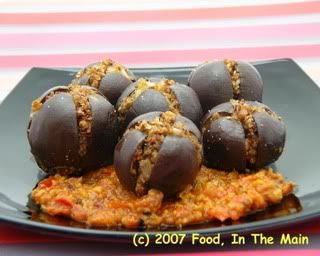
Ingredients:
15 small round baby brinjals with stalks
Pound or grind together the following ingredients to a coarse powder:
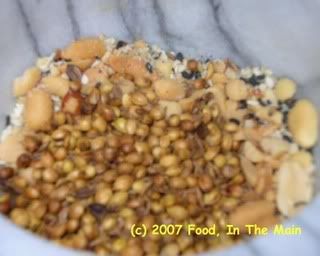
1/3 cup roasted peanuts
2 tbsp dry-roasted coriander seeds
2 tsp dry-roasted cumin seeds
½ tsp aniseed powder
1 tsp red chilly powder
2 tsp sesame seeds (I used 1 tsp black and 1 tsp white)
1/8 tsp powdered methi seeds
Salt to taste

Mix with the coarsely ground powder:
2 tbsp finely minced shallots

Reserve 1 tbsp of this stuffing for the wet masala and use the rest to stuff the baby aubergines.

For the wet masala:
1 tbsp of the stuffing
2 tbsp oil
1 tsp ginger-garlic paste
3 medium tomatoes, finely chopped
Salt to taste
Method:
1. Cut off the stalks of the aubergines so that they sit level on their base. Dont remove the leaf-like bits - they help hold the aubergines together and are edible too.
2. Make two slits in the aubergines, like a "+" sign. Take care not to cut them all the way to the bottom.
3. Gentle separate one half of a slit aubergine with your left hand, and use a small spoon to put the stuffing in. Then open the other half and stuff that as well. Gently brush off any excess masala.
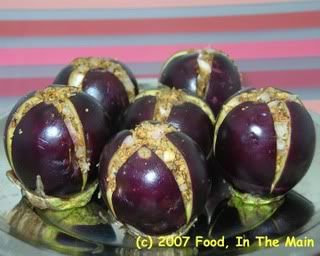
Continue till the aubergines are all stuffed.
4. In a flat wide pan, heat 2 tbsp oil. Drop in the reserved dry masala and fry it for a minute or so.
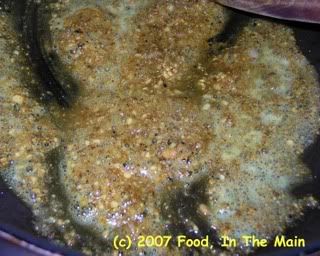
5. Add the chopped tomatoes, a little salt and the ginger-garlic paste and stir it all in.
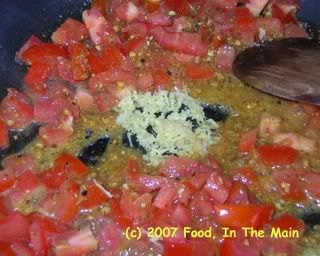
6. Arrange the stuffed aubergines carefully in the pan, making sure they dont fall over. The tomatoes will cook down to a paste as the aubergines cook.
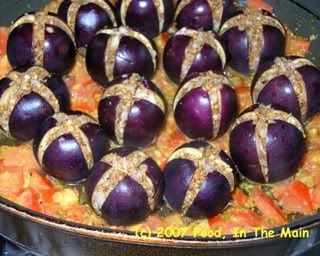
7. Pour about 1/4 cup water carefully around the aubergines, then close the pan and let it simmer on medium-low for 15-20 minutes or till the aubergines are cooked. Check after 15 minutes to make sure that the tomato masala at the bottom has not dried out. Sprinkle a little more water if it looks like it might burn.
8. When the aubergines are soft and done, turn off the heat. Serve hot with chapaties.
Note: I removed each cooked aubergine carefully to a plate and added a couple of tablespoons water to the tomato masala in the pan, just to stir it up. Then I put the masala in a serving dish, arranged the aubergines on top again and served the dish.
It couldnt be helped. I had to say it and get it out of my system. The moment I saw the bag of these dried gungo peas in the shop in Birmingham, the title for a post announced itself in my brain and squatted there, rather like an unwanted caller who ignores all your hints aimed at departure. For a long time I tried to think of something else for a title but, as is evident, no such luck. I just couldnt help being gung-ho about these speckled, rather pretty gungo peas.
What are gungo peas? These are.
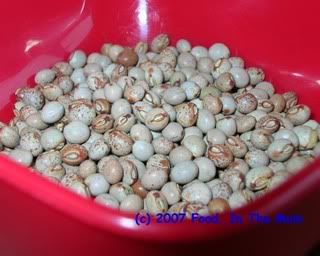
And when they're soaked overnight in water, they become this lovely warm golden brown.

After a quick google for these peas on the Net, I discovered that gungo peas are also known as pigeon peas. Ugh. Pigeon peas. Difficult to be gung-ho about pigeon anything, believe me, much less peas. Pigeons are merely flying rats - and noisy ones at that - as far as I'm concerned, and naming these prettily speckled peas after a verminous bird hardly seems fair to the legume family in general, with most of whom I have a close, personal, in fact daily relationship.
I'm all for gungo peas. (Also all gung-ho about peace.) And now that I have flogged that particular pun to shreds, allow me to present the actual recipe.
Recipe for: Gungo peas masala
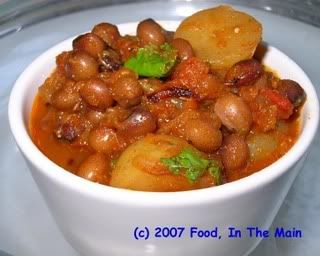
Ingredients:
1/2 cup gungo peas, soaked overnight
3-4 baby potatoes, sliced 1/2-inch thick
1 fresh bay leaf
2 tbsp oil
1 onion - sliced and shallow fried golden brown. Reserve half for the tempering.
1 tomato, chopped
1 tsp pav bhaji masala
½ tsp coriander powder
½ tsp cumin powder
½ tsp dried garlic powder
Salt to taste
To grind to a smooth paste:
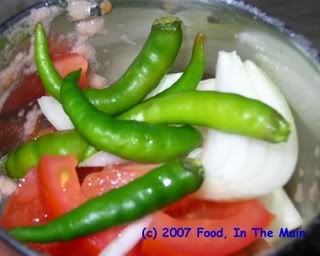
1 onion
1 tomato
4-5 fresh green chillies
handful coriander leaves
For tempering:
1 tbsp ghee
1 tsp cumin seeds
½ tsp garam masala
Reserved fried onions
Fresh coriander leaves for garnish
Method:
1. Put the peas in a pressure cooker vessel and add enough water to just cover the peas. Add the potatoes and pressure-cook till done. Reserve about a cupful of the water in which the peas were cooked.
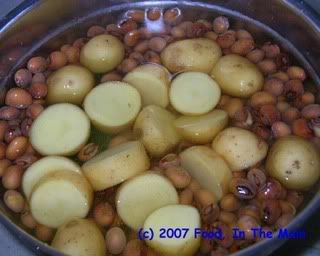
2. In a small frying pan, add 1 tbsp oil and fry the sliced onion till it is golden brown.
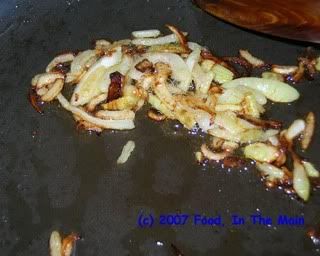
Remove half of the fried onions and reserve.
3. Add the remaining tbsp oil to the fried onions in the pan and pour in the ground tomato-onion-chilly paste.
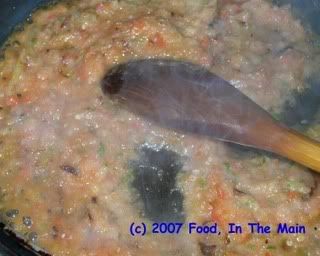
4. Fry till the masala begins to thicken. Then add the chopped tomato to the masala and let it cook down a bit. They should not become totally mushy.

5. Now add the cooked gungo peas and potatoes. Add the coriander powder, cumin powder and garlic powder and stir it all. Add the reserved cupful of water along with salt to taste, and stir again. Let the masala simmer for about 5 minutes on medium-heat.

6. In a small pan, heat 1 tbsp ghee. Fry the cumin seeds (they should splatter and turn brown almost immediately), then add the reserved fried onions and garam masala. Fry for about 30 seconds on high heat.
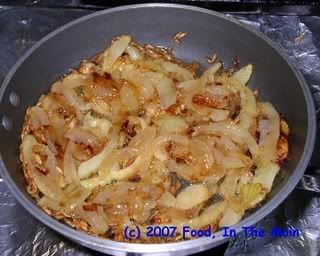
7. Pour this tempering immediately over the peas masala.
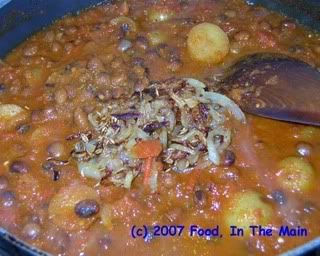
8. Stir it in, sprinkle with chopped coriander and serve hot over plain rice or with chapaties.
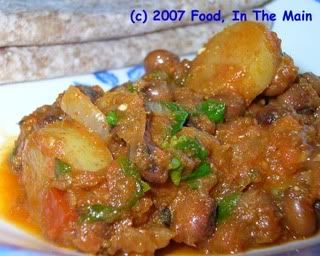
I had a bit of a debate with myself before putting up this post on idli upma, because it seemed almost like cheating to make an entire "recipe" of this dead simple snack. Still - I did it. One is obliged to, on such occasions. Got to keep the flag flying, keep the banner high, grit one's teeth and march on with one's chin firmly elevated. One has one's reputation to keep up, what?
What reputation, you ask?
You know... the reputation. That thing I am known for.
Recipes that are ridiculously simple?
Yep, that will do. That's my rep, and I will keep it up, forsooth!
So here it is - idli upma, that handy snack made from stale(ish) idlis. Fresh idlis arent forbidden from being made into upma, but it would be a bit of a shame to do it to fresh 'uns that are soft and fluffy and crying out for some coconut chutney and sambar and tomato thokku...
Excuse me - I need to get a towel and wipe my face now.
Yes, that's also a reputation I'm obliged to keep up. I was brought up to be polite and wipe up my saliva if it ever left the confines of my mouth.
Disgusted yet? No? Well done, looks like y'all have a reputation to uphold as well - which is, not to be put off by my posts!
Heheh.
Right, I was on about fresh idlis vs stale idlis for making idli upma. By stale, I mean day-old idlis, that's all. I honestly dont make use of food that's actually gone OFF, except as garbage bin fodder. Day-old idlis are easier to work with, as they can be cut up easily. Well, I cut them up with a knife. You can tear 'em up with your hands, of course. But I happen to have a reputation of meticulousness to keep up!
If y'all have quite finished laughing there... thank you. Might I now be allowed to continue?
Idli upma, yeah. I made idli upma because a batch of idlis came out a bit sticky-textured towards the centre. I could have put them back in the steamer, but I didnt. I left them overnight to see if they would unsticky-fy (allow me to introduce a hitherto unknown word), but they hadnt. So upma it had to be. This, by the way, is the most basic of recipes - idli upma can be jazzed up in many different ways.
But here is my recipe.
*phew* It's absolutely exhausting, cooking up a post out of insubstantial ideas!
Recipe for: Idli upma

Ingredients:

4-5 day-old idlis, cut up into small chunks
1 tsp mustard seeds
1 tsp urad dal
3-4 fresh green chillies, sliced into very thin rings
a good pinch of asafoetida powder
4-5 fresh curry leaves
pinch of turmeric powder
2 tsp oil
Chopped fresh coriander for garnish
Method:
1. Heat 1 tsp oil in a pan, drop in the mustard seeds, curry leaves, urad dal and green chilles. Cover and let the seeds pop.
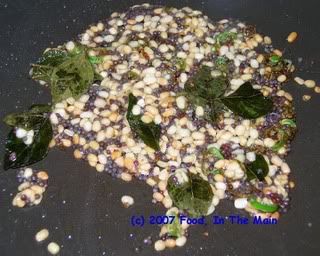
2. Stir in the turmeric and asafoetida powders, then add the cubed idlis.
3. Pour the remaining tsp of oil over the idli pieces and stir gently over medium high heat, so as not to break the pieces up completely.

4. When the pieces are heated through and beginning to turn pale golden in places, turn off the heat. Sprinkle the chopped coriander over the top and serve hot with ketchup.



































